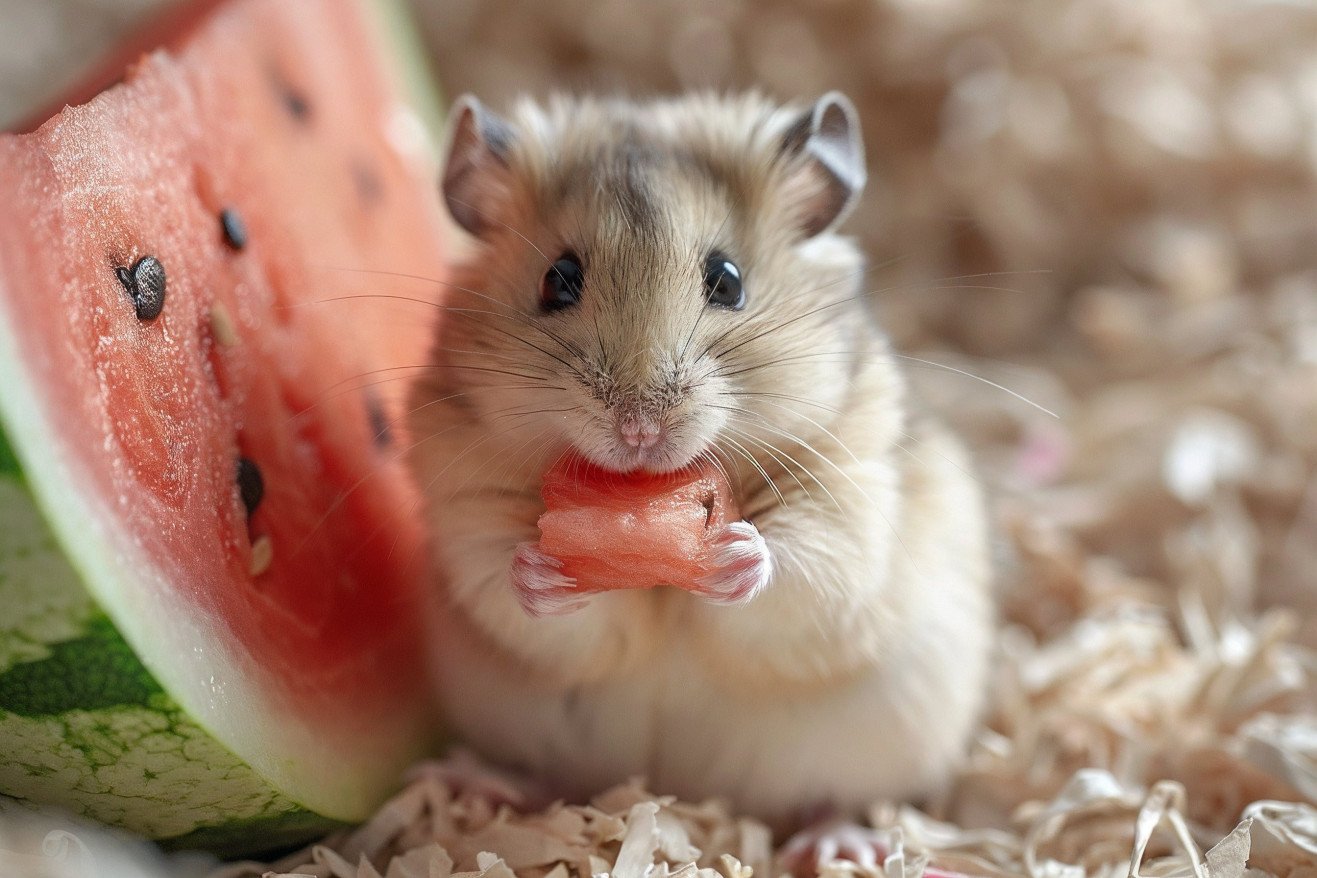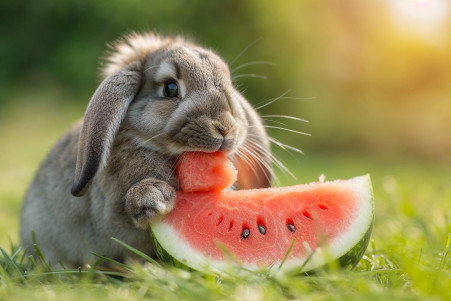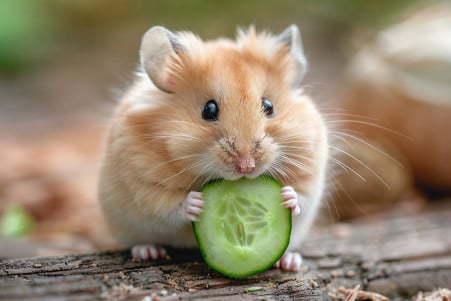Can Hamsters Eat Watermelon? Safe Snacking for Your Pet
24 February 2024 • Updated 22 February 2024

Watermelon is a delicious and refreshing treat, but can you share it with your hamster? Yes, hamsters can eat watermelon, but it should be given in moderation. While it can help keep your pet hydrated and provide some nutritional benefits, it’s high in sugar, so it’s best to limit consumption. Make sure to cut the watermelon into small, seedless pieces and remove any leftovers to avoid spoilage.
To provide a more comprehensive overview of hamster nutrition, this article incorporates veterinary expertise, nutritional data, and information from zoological research. It covers the specific dietary needs of hamsters, the potential impact of different foods on their health, and the right serving sizes to make sure your pet’s diet is well-rounded. With this information from a range of research sources, you can feel confident about how to give your hamster watermelon and other treats.
Can hamsters eat watermelon?
Watermelon Nutrition and How It Fits Into a Hamster’s Diet
In addition to being a favorite summer snack, watermelon is a hydrating fruit that offers a good amount of nutrition that can be good for your hamster. According to Medical News Today, watermelon is made up of mostly water—about 90%—which is great for staying hydrated. It also has vitamin C and antioxidants like lycopene, which can be good for your little pet.
That said, Healthline explains that watermelon is high in sugar, with 9.4 grams per cup. This natural sugar content needs to be kept in check for hamsters because of their small size and the risk of diabetes.
Watermelon also contains fiber, which is important for digestive health. A healthy amount of fiber in the diet can help ensure a healthy gut, which can help with regular bowel movements.
That said, it’s important to make sure that these nutritional benefits are in line with what hamsters need in their diets. Small animals need a diet that meets their specific metabolic and energy needs, and while watermelon can be a good part of that diet, it should be thought of as a treat and not a regular part of their diet.
With that in mind, let’s take a look at how to safely add watermelon to a hamster’s diet, including how much to feed them and how to prepare it.
How to Feed Your Hamster Watermelon
Because of the high sugar content, it’s important to be mindful of how much watermelon you’re feeding your hamster. The Spruce Pets says that fruit should make up no more than 20% of your hamster’s diet, which should otherwise be made up of protein, vegetables, and a small amount of fruit.
When it comes to watermelon, a piece about the size of a dice cube, given once or twice a week, is a good portion size for a hamster. This way, they can get the benefits of the fruit without overdoing it.
When you first start feeding your hamster watermelon, make sure to give them a small portion and watch for any changes in their digestion or any allergic reactions. Trupanion also notes that it’s important to make sure that you remove any seeds and rind from the watermelon to avoid choking and other digestive issues.
After you feed your hamster watermelon, make sure to watch for any signs of an adverse reaction, like diarrhea or a change in their normal behavior.
Because watermelon is made up of almost 92% water and is full of important vitamins, it should be considered a special treat, according to Trupanion. That said, it should still be considered a treat and not a regular part of your hamster’s diet. This means that it should be part of a balanced diet and help contribute to your hamster’s overall health while also keeping their diet interesting.
Putting Together a Well-Balanced Diet for Your Hamster
Making sure that your hamster is getting all of the nutrients that they need is essential to their overall well-being. According to The Spruce Pets, a well-balanced hamster diet includes a combination of high-quality pellets, seeds, fresh fruits and vegetables, and the occasional treat.
Pellets are packed with nutrients and should make up the bulk of your hamster’s diet, while seeds add some variety. Fresh fruits and vegetables should make up about 20% of your hamster’s diet and will provide them with important vitamins and hydration.
That said, it’s important to feed your hamster these foods in moderation, especially when it comes to fruits like watermelon, which is high in sugar and can lead to obesity and diabetes in hamsters.
In addition to watermelon, you can also feed your hamster small amounts of other fruits like apples, pears, and berries, while avoiding citrus fruits as recommended by PDSA.
You can also feed your hamster vegetables like carrots and broccoli to ensure that they’re getting a good mix of nutrients. Both PDSA and the RSPCA recommend offering your hamster chewing materials like cardboard and untreated wood, which are essential for dental health and mental stimulation.
Overall, you’ll want to make sure that your hamster’s diet is well-rounded and includes a variety of different foods that will mimic their natural foraging behaviors. This means that you’ll want to make sure that their diet includes a mix of different textures and flavors that will keep them interested and engaged.
That said, it’s important to make sure that you’re feeding your hamster a varied diet without overdoing it, so make sure that you’re feeding them a little bit of everything that they need.
Understanding How Hamsters Process Sugar and Watermelon
Hamsters’ specific metabolic processes play a role in how they process sugar and the impact that has on their health. For example, a paper from PubMed by M N Goodman notes that dietary carbohydrates, including the fructose in watermelon, can cause insulin resistance in golden Syrian hamsters. This means that it’s important to be careful about feeding hamsters sugary fruits like watermelon since they are already predisposed to diabetes.
In addition, as noted in The Hamster as a Model for Human Ingestive Behavior on the NCBI Bookshelf, hamsters’ natural behaviors include hoarding and nocturnal foraging. These behaviors, in combination with their metabolic processes, suggest that while the hydrating properties of watermelon are consistent with what hamsters need in their diet, the sugar in watermelon may be too much for their limited tolerance.
Meanwhile, a study from PubMed by N Rowland points out that Syrian hamsters adjust their energy intake throughout the day with different feeding patterns, which could be disrupted by the addition of sugary treats. Because they are most active at night and tend to hoard food, this could mean that watermelon is best offered in small amounts and only occasionally.
This careful balance would allow hamsters to enjoy the hydrating properties of watermelon without overloading their sugar metabolism.
Hydration and Fiber: The Benefits of Watermelon’s Water Content
Proper hydration is important for hamsters, and water-containing fruits like watermelon can help ensure that hamsters are getting enough fluids. Studies on the golden hamster, as noted in a ScienceDirect article, have shown that the forestomach is not necessary for nutrition in hamsters with adequate diets, but hydration is still important. Watermelon can help ensure that a hamster stays hydrated due to its water content, especially in the summer months or in drier environments.
Watermelon’s fiber content is also important because it may help with digestive health. A study in The Journal of Nutrition showed that dietary fiber, especially that with higher viscosity, can lower cholesterol in hamsters. This suggests that the soluble fiber in watermelon may help maintain a healthy gut and even help regulate cholesterol levels in small animals.
A PMC article notes that the physicochemical properties of dietary fibers, including fermentability, are important for their impact on the gut. While watermelon’s fiber content is lower than that of many other fruits and vegetables, it can still help contribute to a healthy gut microbiome.
So, while watermelon can help with hydration, it’s important to note that it should not be used as a replacement for water. However, it can help contribute to a hamster’s hydration and fiber needs if given in moderation.
Conclusion: Can Hamsters Eat Watermelon?
In summary, watermelon can be a fun way to add some hydration and nutrition to your hamster’s diet as long as it is fed in moderation. As we’ve discussed, the water in watermelon can be helpful, and the vitamin C and lycopene in the fruit can be good for your hamster. However, the sugar in watermelon is a big downside, so it’s important to make sure you’re feeding it to your hamster responsibly.
Feeding your hamster the right portion sizea small, seedless piece of watermelon without the rind, every once in a whilewill help ensure that your hamster can take advantage of the benefits of watermelon without the drawbacks. Feeding your hamster watermelon in moderation and making sure that the rest of their diet is made up of pellets, seeds, and vegetables will help reduce the risk of health problems like diabetes and obesity.
It’s important to remember that every hamster is different, and individual hamsters may react differently to different foods. Make sure to keep an eye on your hamster after you feed them any new treats, including watermelon, and talk to your vet to make sure that you’re feeding your hamster a diet that’s right for them.
Doing your research and getting expert advice will help you make sure that you’re taking the best care of your pet and that your hamster is as healthy and happy as possible.


